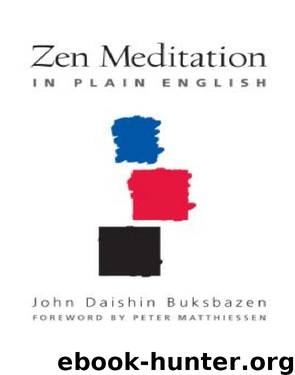Zen Meditation in Plain English by John Daishin Buksbazen

Author:John Daishin Buksbazen
Language: eng
Format: epub, azw3
Publisher: Wisdom Publications
Published: 2010-07-11T16:00:00+00:00
Practice is like regular exercise,
which builds strength, gracefulness, and self-confidence
to meet the situations we all face every day.
And it is like a laboratory, in which we can continuously test
our understanding to see if it is adequate or not.
If we never test our beliefs,
we cannot find out their truth or falsity.
Maezumi Roshi
PART THREE:
COMMUNITY
WHAT IS COMMUNITY?
SO FAR, everything described could be practiced by a solitary individual. But true Zen practice cannot be fully experienced in all its diversity and richness by just one person alone. Sooner or later it becomes important to join with a group of people who together form a community of practice.
This community of practice comes out of each person’s determination to achieve some fundamental understanding of what this life really means, what this self really is.
If a buddha is one who realizes and lives enlightenment, and sitting is the deepest expression of that realization and life, then community is nothing other than going deeper and deeper into that realization, and becoming more and more at one with that life.
This happens most readily and most fully when we are doing it in the company of others who are doing the same thing.
There are various ways to practice with others, ranging from the highly structured schedule and disciplines of a training center or monastery to the less formal but equally valuable style of many practice groups. Each form is likely to be suited to the capacities and needs of some practitioners more than others. Find the community that suits you best.The more rigorous forms offer certain advantages; the more informal groups offer others. No one form is necessarily better than another per se; each should be appreciated for what it offers.
Although we may not immediately see it clearly, practicing together can be very helpful in discovering that we can be naturally in harmony with all sorts of situations, with all beings and with all conditions, as well as with the many facets of our own selves. Being in harmony, though, does not necessarily imply a state of unbroken sweetness and light. Rather, harmony suggests a readiness to deal appropriately with all events and circumstances without becoming separate or alienated from either oneself or one’s surroundings. Practice together is a harmony based on this single, clear realization: that everything—you, me, the whole universe as it is—is one.
Each person, each moment, and each event exists only as a result of all that has gone before it and thus is the tip of a vast iceberg of cause and effect. When we see only that tip, we miss the connections that make it one with us, and so we have the impression of conflict and separateness. But however convincing that impression may be, in sitting we can experience it more intimately. And it is in such a moment of recognition that we come face to face with the oneness that goes beyond conflict, discouragement, and the limited illusions of common sense.
Of course, that doesn’t imply a passive acceptance of events or conditions. Members
Download
Zen Meditation in Plain English by John Daishin Buksbazen.azw3
This site does not store any files on its server. We only index and link to content provided by other sites. Please contact the content providers to delete copyright contents if any and email us, we'll remove relevant links or contents immediately.
| Book of Common Prayer | Catechisms |
| Devotionals | Hymns & Hymnals |
| Meditations | Monasticism & Asceticism |
| Pentecostal & Charismatic | Prayerbooks |
| Rites & Ceremonies | Sacraments |
The Secret Power of Speaking God's Word by Joyce Meyer(3067)
More Language of Letting Go: 366 New Daily Meditations by Melody Beattie(3002)
To Light a Sacred Flame by Silver RavenWolf(2787)
How Proust Can Change Your Life by Alain De Botton(2771)
Anxious for Nothing by Max Lucado(1941)
A TIME TO KEEP SILENCE by Patrick Leigh Fermor(1880)
Curse Tablets and Binding Spells from the Ancient World by Gager John G.;(1851)
The Gnostic Gospel of St. Thomas by Tau Malachi(1767)
7 Secrets of Divine Mercy by Vinny Flynn(1711)
all by Unknown Author(1663)
365 Tao: Daily Meditations by Ming-Dao Deng(1602)
From Good Goddess to Vestal Virgins: Sex and Category in Roman Religion by Ariadne Staples(1553)
100 Days of Thanks by Thomas Nelson(1542)
To Ride a Silver Broomstick by Silver RavenWolf(1537)
Anam Cara by John O'Donohue(1529)
The Fasting Edge by Jentezen Franklin(1518)
To Stir a Magick Cauldron by Silver RavenWolf(1505)
The Sacred Enneagram by Christopher L. Heuertz(1417)
New Morning Mercies by Paul David Tripp(1371)
